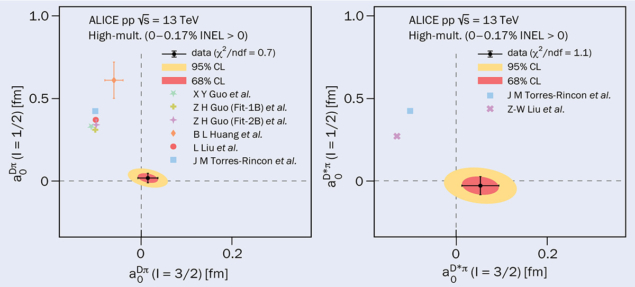A report from the ALICE experiment.

In the past two decades, it has become clear that three-quark baryons and quark–antiquark mesons cannot describe the full spectrum of hadrons. Dozens of exotic states have been observed in the charm sector alone. These states are either interpreted as compact objects with four or five valence quarks or as hadron molecules, however, their inner structures remain uncertain due to the complexity of calculations in quantum chromodynamics (QCD) and the lack of direct experimental measurements of the residual strong interaction between charm and light hadrons. New femtoscopy measurement by the ALICE collaboration challenge theoretical expectations and the current understanding of QCD.
Femtoscopy is a well-established method for studying the strong interactions between hadrons. Experimentally, this is achieved by studying particle pairs with small relative momentum. In high-energy collisions of protons at the LHC, the distance between such hadrons at the time of production is about one femtometre, which is within the range of the strong nuclear force. From the momentum correlations of particle pairs, one extracts the scattering length, a0, which quantifies the final-state strong interaction between the two hadrons. By studying the momentum correlations of emitted particle pairs, it is possible to access the final-state interactions of even short-lived hadrons such as D mesons.
The scattering lengths are significantly smaller than the theoretical predictions
The ALICE collaboration has now, for the first time, measured the interaction of open-charm mesons (D+ and D*+) with charged pions and kaons for all the charge combinations. The momentum correlation functions of each system were measured in proton–proton collisions in the LHC at a centre-of-mass energy of 13 TeV. As predicted by heavy-quark spin symmetry, the scattering lengths of Dπ and D*π agree with each other, but they are found to be significantly smaller than the theoretical predictions (figure 1). This implies that the interaction between these mesons can be fully explained by the Coulomb force, and the contribution from strong interactions is negligible within experimental precision. The small measured values of the scattering length challenge our understanding of the residual strong force of heavy-flavour hadrons in the non-perturbative limit of QCD.
These results also have an important impact on the study of the quark–gluon plasma (QGP) – a deconfined state of matter created in ultra-relativistic heavy-ion collisions. The rescattering of D mesons with the other hadrons (mostly pions and kaons) created in such collisions was thought to modify the D-meson spectra, in addition to the modification expected from the QGP formation. The present ALICE measurement demonstrates, however, that the effect of rescattering is expected to be very small.
More precise and systematic studies of charm–hadron interactions will be carried out with the upgraded ALICE detector in the upcoming years.
Further reading
ALICE Collab. 2024 arXiv:2401.13541.





